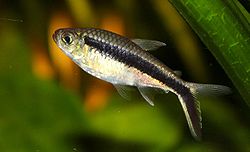| Thayeria | |
|---|---|
 | |
| Thayeria boehlkei | |
| Scientific classification | |
| Kingdom: | Animalia |
| Phylum: | Chordata |
| Class: | Actinopterygii |
| Order: | Characiformes |
| Family: | Acestrorhamphidae |
| Subfamily: | Thayeriinae |
| Genus: | Thayeria C. H. Eigenmann, 1908 [1] |
| Type species | |
| Thayeria obliquus C. H. Eigenmann, 1908 [1] | |
| Species | |
See text | |
Thayeria is a genus of freshwater ray-finned fishes belonging to the family Acestrorhamphidae, the American characins. The fishes in this genus are found in the Amazon Basin, and the Approuague and Maroni Rivers in tropical South America. It includes three species, including the blackline penguinfish, T. boehlkei. Members of this genus, among other characteristics, are small, have one lateral black stripe, and have a vesica piscis shape. They are peaceful.